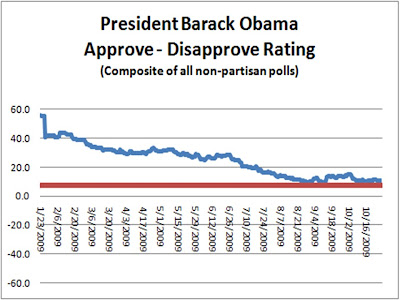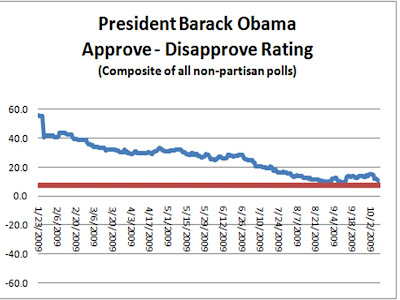While the "official" declaration of the start and end of a recession comes months later after economic analysts have poured over reams of data on economic performance, the 3.5% growth in Real Gross Domestic Product in the 3rd quarter of this year is sufficient to declare with a very high probability that the so-called "great recession" has ended in the United States.
As a reminder, Gross Domestic Product is a measure of the value of all goods and services produced in the United States in a given time period. It is the most comprehensive measure of the health of the economy essentially because the value of everything produced equates to the value of goods and services that Americans will receive in that quarter -- in other words, we get something for the value that we generate. You can see the last 3 years of GDP growth in the chart below, with the negative quarters, where the economy was actually shrinking, in red.
 With a total economic contraction of 3.8%, this ranks right up there with the worst recessions of the Post-World War II era, trailing only the Great Depression, but trailing it by a massive margin (we are talking greater than a 5:1 ratio.) There is a legitimate debate about whether this recession was worse than the double-dipper in 1981-1982 that saw unemployment surge above 10% and mass inflation to go with the economic stagnation (something that we fortunately do not see today, at least yet.)
With a total economic contraction of 3.8%, this ranks right up there with the worst recessions of the Post-World War II era, trailing only the Great Depression, but trailing it by a massive margin (we are talking greater than a 5:1 ratio.) There is a legitimate debate about whether this recession was worse than the double-dipper in 1981-1982 that saw unemployment surge above 10% and mass inflation to go with the economic stagnation (something that we fortunately do not see today, at least yet.)So if the recession is over, when do things get back to normal? Depends what normal is and what happens going forward.
Keep in mind that the chart above talks about TOTAL GDP. The wealth-generation that people feel in their wallets relates to PER CAPITA GDP, or the total GDP divided by the number of people in this country.
Our population grows by about 1% per year. Therefore, just to keep the same standard of living, the total GDP has to grow by 1%. Any less and our standard of living is slipping. Any more and it is improving, as it historically has.
Think of it this way: if there were 2 people in the country and we made 2 cars in a year, that's 1 new car per person per year. If the population grows to 3 people, we now have to make 3 cars in a year for those 3 people to maintain the same standard of living that the 2 people previously had.
The recession, with all its quarters of negative growth have driven a significant gap in per capita GDP versus its high in the 4th quarter of 2007, when the recession began. The chart below shows the trend in Per Capita GDP.
 If we were to maintain the 3.5% annual GDP growth rate that we had last quarter (which is a tall order in and of itself -- more on that later), it would take until the 3rd quarter of 2011 just for per capita GDP to get back to where it was before the recession.
If we were to maintain the 3.5% annual GDP growth rate that we had last quarter (which is a tall order in and of itself -- more on that later), it would take until the 3rd quarter of 2011 just for per capita GDP to get back to where it was before the recession.That's a long time to suffer through high unemployment and declining wages. And there is no assurance that this growth rate will continue. The economy faces significant short-term headwinds, although also some long-term reasons to be optimistic.
Head and Tail Winds
There are many reasons to be concerned in the short-term:
- A large portion of the growth in the third quarter was created by government stimulus. Cash for clunkers is now gone, the first-time home buyer tax credit may or may not get extended and other stimulus spending and tax cuts will end eventually. Essentially we've grown through government leverage, but that can't last forever
- Unemployment is still very high, at 9.8% and predicted to rise further (although it feels like we are nearing the peak.) High unemployment squashes consumer spending, which in terms impacts growth in the near-term.
- Consumer confidence is still sagging. After recovering from downright scary levels in the winter, when it was 20% of the 1985 benchmark it is measured against, it rose throughout the spring, but still now stands at just 47.7% of its 1985 level, having declined each of the past two months. If consumers aren't confident, they aren't likely to spend.
- Productivity is surging -- worker productivity rose 6.6% in the 2nd quarter of 2009. Productivity is the single best indicator of long-term economic growth, because the more an individual outputs per hour of work, the more that there is to go around, once you get people working.
- Stimulus is not over -- we have a lot of stimulus money left to spend -- more on that later
- History is on our side -- double-dip recessions are actually very rare -- 1981/1982 was the exception not the rule. In the modern era, Americans have shown the capability to buckle down and grow the economy after a recession. Consider the boom that followed the 1990/1991 recession, where we saw some of the best economic growth in the countries history.
- Innovation could be the key -- just as the internet unlocked productivity and output in the past decade, new technology will be the key if we are going to launch into a new era of prosperity. We have still not fully leveraged the internet. Green energy could be a whole new economic boom segment. Upgrading and rebuilding the nation's infrastructure could be a growth industry.
The short-term is a little more dicey and harder to call. Will the economy sink back down as stimulus pulls out? Will consumer confidence drag on the economy for some time to come? Economists are split. I think we will continue to grow, but the question is how fast -- will it be enough to solve massive unemployment and consumer confidence or just enough to maintain our now-reduced standard of living?
More Stimulus? Too Much Stimulus?
The second quarter growth numbers have ended debate among serious economists about whether the stimulus had an impact on the US economy -- every credible financial news source cites stimulus funding as one of the major factors behind the return to growth in the second quarter. Clearly, programs like Cash for Clunkers and the Home Buyer Credit helped spur spending and growth.
Critics on the right argue that this a short-term bump up and that we will face negative longer-term consequences as government debt rises and the stimulus abates. They say that any benefit from the stimulus is not worth the long-term cost.
Critics on the left, on the other hand, argue that this simply proves that we didn't do enough stimulus, that the original bill should have been larger, that we probably need a second stimulus shot in the arm.
The White House won't dare to propose that we do something called a second "stimulus" bill, but as I noted a few weeks ago, has been quietly moving to make some small moves, such as extending unemployment benefits and the first-time home-buyer credit.
But there is still a lot of juice left in the first stimulus bill too. As of the latest reports:
Spending -- $123.5 billion of the $499 billion allocated has been paid out as of last week or 24.7%
Tax Cuts -- $83.8 billion of the $288 billion in tax cuts have been paid out or 29.1%
In total of the $787 billion stimulus package, about $207.3 billion has been paid out or 26.3% of the bill's total.
While I had argued that the money needed to go out faster to give the economy a quick shot in the arm, the good news in these numbers is that there are a lot of legs left in the existing stimulus package. If we spent about 26.3% of the bill's allocation and we managed to achieve 3.5% GDP growth for a quarter, it stands to reason that if that money is spent appropriately, we should be able to maintain that growth rate for several more quarters as the balance of the funds are paid out of the course of this year and next year.
The risk is that the most "stimulative" programs, such as Cash for Clunkers may have past and whether the bill continues to drive economic progress will depend on the effectiveness of the remaining programs.
All in all, not only would it be political suicide, it would seem to me to be fool-hardy to propose another stimulus when there is so much left to go on the existing bill.
The economy is a complex beast and if anyone understood all the twists and turns that it takes, that person would probably be able to get very wealthy and might not share that information with the rest of us.
However, the recent news is, on balance encouraging. We aren't on the verge of financial collapse anymore, the economy is growing and unemployment will eventually peak. But there will be more pain along the way.
Thanks for reading. If you like this site, tell your friends.

















